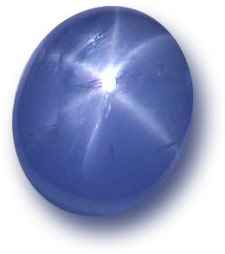

A star sapphire is a type of sapphire that exhibits a star-like phenomenon known as asterism; red stones are known as "star rubies". Star sapphires contain intersecting needle-like inclusions following the underlying crystal structure that causes the appearance of a six-rayed "star"-shaped pattern when viewed with a single overhead light source. The inclusion is often the mineral rutile, a mineral composed primarily of titanium dioxide.[1] The stones are cut en cabochon, typically with the center of the star near the top of the dome. Occasionally, twelve-rayed stars are found, typically because two different sets of inclusions are found within the same stone, such as a combination of fine needles of rutile with small platelets of hematite; the first results in a whitish star and the second results in a golden-colored star. During crystallization, the two types of inclusions become preferentially oriented in different directions within the crystal, thereby forming two six-rayed stars that are superimposed upon each other to form a twelve-rayed star.[2] Misshapen stars or 12-rayed stars may also form as a result of twinning. The inclusions can alternatively produce a cat's eye effect if the girdle plane of the cabochon is oriented parallel to the crystal's c-axis rather than perpendicular to it. To get a cat's eye, the planes of exsolved inclusions must be extremely uniform and tightly packed. If the dome is oriented in between these two directions, an off-center star will be visible, offset away from the high point of the dome.[3]:101
At 1404.49 carats, The Star of Adam is the largest known blue star sapphire. The gem was mined in the city of Ratnapura, southern Sri Lanka.[4] The Black Star of Queensland, the second largest star sapphire in the world, weighs 733 carats.[5] The Star of India mined in Sri Lanka and weighing 563.4 carats is thought to be the third-largest star sapphire, and is currently on display at the American Museum of Natural History in New York City. The 182-carat Star of Bombay, mined in Sri Lanka and located in the National Museum of Natural History in Washington, D.C., is another example of a large blue star sapphire. The value of a star sapphire depends not only on the weight of the stone, but also the body color, visibility, and intensity of the asterism. The color of the stone has more impact on the value than the visibility of the star. Since more transparent stones tend to have better colors, the most expensive star stones are semi-transparent "glass body" stones with vivid colors.[3]:348–350
On 28 July 2021, the world's largest cluster of star sapphires, weighing 510 kg, was unearthed from Ratnapura, Sri Lanka. This star sapphire cluster was named "Serendipity Sapphire".[6][7]
References[edit]
- ↑ Emsley, John (2001). Nature's Building Blocks: An A-Z Guide to the Elements. Oxford: Oxford University Press. pp. 451–53. ISBN 978-0-19-850341-5. Search this book on

- ↑ DuToit, Garry. "Twelve-Rayed Star Sapphire of Interest" (PDF). GIA Laboratory, Bangkok. Archived from the original (PDF) on 28 March 2014. Retrieved 2014-08-14. Unknown parameter
|url-status=ignored (help) - ↑ 3.0 3.1 Cite error: Invalid
<ref>tag; no text was provided for refs namedhughes - ↑ Sivaramakrishnan, P (4 January 2016). "World's largest blue star sapphire 'found in Sri Lanka'". BBC News. BBC. Retrieved 5 January 2016.
- ↑ Kim, Victoria (5 January 2010). "For some, a sapphire has not been their best friend". Los Angeles Times. Retrieved 5 January 2010.
- ↑ "World's largest star sapphire cluster found in backyard". www.9news.com.au. Retrieved 2021-07-28.
- ↑ Salo, Jackie (2021-07-27). "World's largest sapphire cluster worth $100M found in backyard in Sri Lanka". New York Post. Retrieved 2021-07-28.
